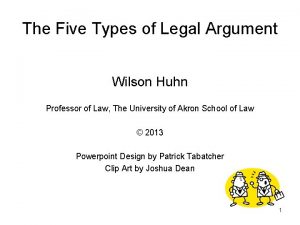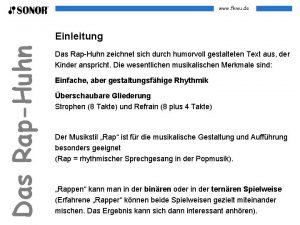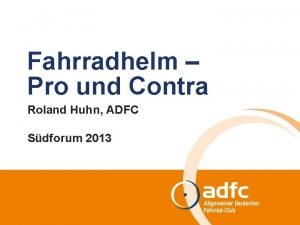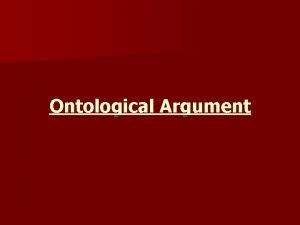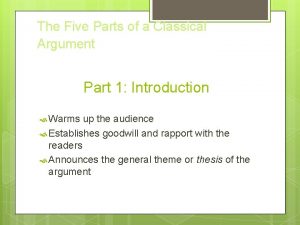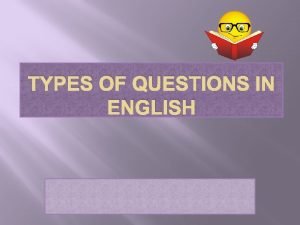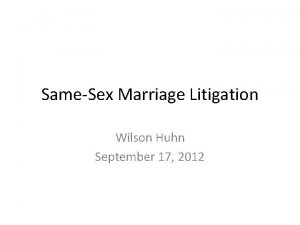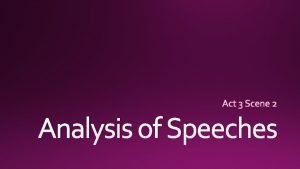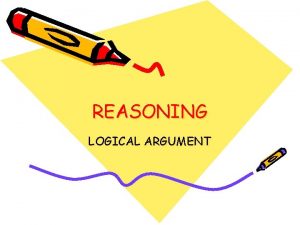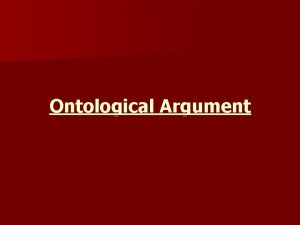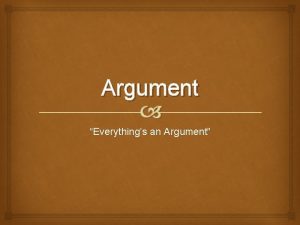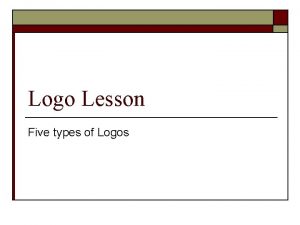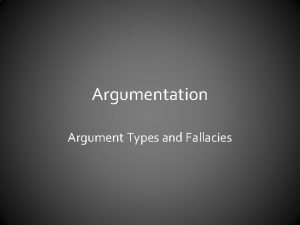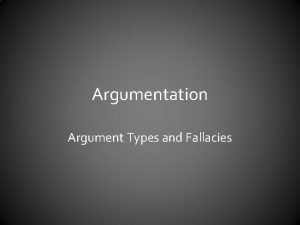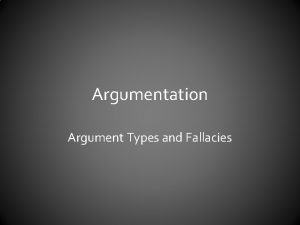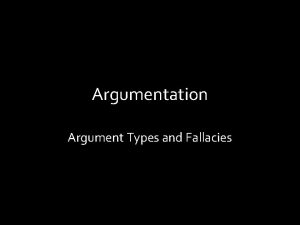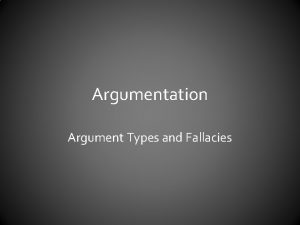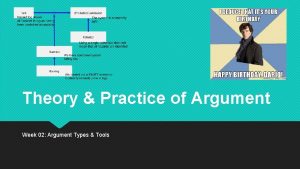The Five Types of Legal Argument Wilson Huhn
























































- Slides: 56

The Five Types of Legal Argument Wilson Huhn Professor of Law, The University of Akron School of Law © 2013 Powerpoint Design by Patrick Tabatcher Clip Art by Joshua Dean 1

Timeline Huhn started teaching law __________________ 1980 1984 1988 1992 1996 Ronald Reagan Bush I Bill Clinton 2000 2004 2008 2012 George W. Bush Barack Obama 2

Courses Taught Health Law Evidence Administrative Law Secured Transactions Law and Genetics Commercial Paper Jurisprudence Constitutional Law II 3

Scholarly Research Freedom of Expression State Action Doctrine Gay Rights Eavesdropping Waterboarding Affordable Care Act Logic and Legal Reasoning The Stages of Legal Reasoning 4

Recent 5 to 4 Decisions in the Supreme Court Citizens United (corporations have the right to run political advertisements) Van Orden v. Perry (10 Commandments obelisk constitutional) Bush v. Gore (recount halted in 2000 election) Grutter v. Bollinger (affirmative action upheld) 5

Supreme Court Justices Felix Frankfurter Sandra Day O’Connor Harry Blackmun Oliver Wendell Holmes, Jr. John Roberts Thurgood Marshall 6

7

Presentation One: Introduction and Textual Arguments Introduction to the Five Types of Legal Arguments Textual Arguments: Plain Meaning, Canons of Construction, and Intratextual Arguments 8

Why Are There Hard Cases? Why do informed and reasonable people differ as to what the law is? 9

The Five Types of Legal Arguments Text Intent Precedent Tradition Policy 10

Proof of What the Law Is To prove a question of fact, lawyers call witnesses and introduce exhibits. To prove a question of law, lawyers create legal arguments, drawing on legal text, intent, precedent, traditions, and policy. The different types of legal argument are the “data” that lawyers use to prove what the law is. 11 Text Intent Precedent Tradition Policy

Rules of Recognition The legal philosopher H. L. A. Hart said that underlying the law are “rules of recognition” – rules that govern what “counts” as law. The five types of legal arguments operate as rules of recognition. Judges and lawyers recognize arguments based upon text, intent, precedent, tradition, and policy as being legitimate forms of argument. 12

Source and Structure Each different type of argument draws on different sources of information and has a different structure. 13

Strengths and Weaknesses Each type of argument has characteristic strengths and weaknesses, and may be attacked or evaluated in different ways. 14

Why Identify the Different Types of Legal Arguments? It is important for legal professionals to understand the different types of legal arguments As students As lawyers As judges 15

As Students As students of the law, understanding the different types of arguments helps us to analyze difficult questions of law. 16

As Lawyers As lawyers representing clients, understanding the different types of arguments helps us to choose the best arguments on our clients’ behalf. 17

As Judges As judges deciding cases, understanding the different types of arguments helps to decide which arguments are most persuasive. 18

Secondary Sources of Law The five types of legal arguments are primary sources of evidence of what the law is. All other materials are secondary sources of law. Secondary sources about the law include legal treatises, textbooks, monographs, articles, essays, and study aids. Some legal treatises are very influential – but they are not law by themselves. Instead they cite the law. 19

The Five Presentations In This Series 1 – Introduction; Textual Arguments – Plain Meaning, Canons of Construction, and Intratextual Arguments 2 – Historical Arguments – Intent, Precedent, and Tradition 3 – Policy Arguments 4 – Identifying and Attacking the Different Types of Arguments 5 – The Stages of Legal Reasoning – Logic, 20 Analogy, and Policy

1. Legal Textual arguments look to the text of the law itself to determine what the law is. 21

Examples of Legal Text Includes: Constitutions Statutes Ordinances Regulations Contracts Deeds Wills 22

There Are Three Sub-Types of Textual Arguments A. Plain Meaning B. Canons of Construction C. Intratextual Arguments 23

Plain Meaning The most basic type of legal argument is one that is based upon the “plain meaning” of legal text. The law is simply what the words of the constitution, statute, regulation, or ordinance mean. 24

There Are Several Three Sources of “Plain Meaning” Lay usage Dictionary definitions “Terms of Art” – words that have a specialized meaning in the law Definitional sections in statutes 25

Some Laws Are Clear 26

The Law of Murder (State Law) No person shall intentionally cause the death of another human being. 27

Law Against Use of a Weapon of Mass Destruction (federal law) 18 U. S. C. § 2332 a(a) - Use of a Weapon of Mass Destruction: A person who, without lawful authority, uses, threatens, or attempts or conspires to use, a weapon of mass destruction … shall be imprisoned for any term of years or for life, and if death results, shall be punished by death or imprisoned for any term of years or for life. 28

“Weapon of Mass Destruction” Defined 18 U. S. C. 2332 a(c) - Definitions: For purposes of this section … the term “weapon of mass destruction” means … any destructive device as defined in section 921 of this title. 29

“Destructive Device” Defined 18 U. S. C. 921(a)(4)(A)(i): As used in this chapter … the term “destructive device” means … any explosive … bomb. 30

“Plain Meaning” Arguments Are Determinative … Unless … You might think that the law ALWAYS consists of “plain meaning” arguments – but that is not the cases. With almost every law there are situations where the meaning of the law is unclear in certain situations. In addition, the courts will not apply the “plain meaning” of legal text if it would lead to an “absurd” result. 31

Many Laws Are Not Clear: “No Vehicles in the Park” 32

Rules and Standards Some laws are very clear and specific – these are rules. Other laws are vague and general – these are standards. 33

Example of a Rule “Stop at red light. ” • Rules are clear, but may be unfair. – Rules are efficient in situations where facts of different cases are basically similar. • Rules are difficult to create but easy to apply. – Example: specific emissions limits for industries • Rules are applied formalistically – Do the facts of the case match the fact portion of the rule? 34

Example of a Standard “Proceed cautiously on yellow light” • Standards are fair, but may be ambiguous – Standards are efficient where it is necessary to cover many different fact situations • Standards are easy to create but difficult to apply – Example – “reasonable person” standard in tort law • Standards are applied realistically – What are the facts, what are the underlying values and interests to be considered, and how are those values and interests involved in the case to be decided? 35

More Examples of Standards Due Process: Judicial and administrative procedures must be “fundamentally fair. ” Equal Protection: Persons who are “similarly situated” must be treated alike. The Law of Tort: Persons must according to what the “reasonable person” would do under the circumstances. 36

If the Law Is Not Absolutely Clear … If the text of the law is not determinative, then it opens the door to every other form of legal argument … … including other types of textual arguments as well as arguments based on intent, precedent, tradition, and policy. 37

B. The Canons of Construction The canons of construction are not “rules” of law. They are instead general presumptions about how legal text should be interpreted. The canons of construction are analogous to rules of syntax, like the rules governing word order in English: “Only I love you” or “I love only you. ” 38

There Are Dozens of Canons of Construction 39

Some Canons of Construction Are Similar to Each Other The Rule of Lenity: “Criminal statutes are to be narrowly construed against the state and in favor of the defendant. ” “Ambiguous words in a contract that is drafted by only one of the parties such as an insurance policy should be construed against the party who drafted it and in favor of the other party. ” 40

Some Canons of Construction Are in Contradiction to Each Other Statutes in derogation of common law are to be narrowly construed. Remedial statutes must be broadly construed. 41

Example: Dogs Allowed – How About Cats? Suppose you are travelling with your cat and see this sign outside a restaurant – Is your cat welcome? 42

Canon Number 1 Expressio Unius Canon Number 1: Expressio unius est exclusio alterius - meaning, “to say the one is to exclude the other” – So “Dogs Allowed” means “Cats Not Allowed” 43

Canon Number 2: Ejusdem Generis – meaning, “of the same kind” So “Dogs Allowed” means “Cats Also Allowed” 44

For Every Canon There Is an Equal and Opposite Canon Llewellyn studied the canons of construction and discovered that for every canon of construction there is an opposite canon. Karl Llewellyn 45

Llewellyn’s List of Canons (first six) Karl Llewellyn, Remarks on the Theory of Appellate Decision and the Rules or Canons About How Statutes Are to Be Construed, 3 Vanderbilt Law Review 395 (1950) 46

C. Intratextual Arguments Look to one portion of legal text to interpret another portion of same text – Same word used more than once – Different words used in different places – Organization or structure of the document 47

The Necessary and Proper Clause One of the most important passages in the Constitution is the Necessary and Proper Clause, Article I, Section 8, Clause 18. It is understood to mean that Congress not only has express powers, but also has implied powers to act. 48

Necessary and Proper Clause Article I, Section 8, Clause 18: Congress shall have power to make all Laws which shall be necessary and proper for carrying into execution the foregoing powers and all other powers vested by this Constitution in the government of the United States, or in any department or officer thereof. 49

Mc. Colloch v. Maryland (1819) When the United States was formed one of the principal issues was whether the country should have a central bank – a government-owned bank that could be used to hold and transfer government funds. Congress created the Bank of the United States. In this case the State of Maryland argued that Congress did not have the power to create a bank, because that power was not expressly listed in the 50 Constitution.

The Arguments The United States contended that the Bank of the United States was created to facilitate both taxation and spending, and could be used to purchase materials and support the army, navy, and movement of the armed forces. The State of Maryland argued that the bank wasn’t “necessary” for any of these purposes. 51

Chief Justice Marshall’s Two Intratextual Arguments Contrast between “necessary and proper” and “absolutely necessary” Placement of the Necessary and Proper Clause among the powers of Congress 52

“Necessary and Proper” versus “Absolutely Necessary” Article I, Section 8, Clause 18: “Congress shall have power to make all Laws which shall be necessary and proper …” Article I, Section 10, Clause 2: “No State shall, without the Consent of the Congress, lay any Imposts or Duties on Imports or Exports, except what may be absolutely necessary for executing it's inspection Laws …” 53

Placed Among the Powers of Congress, Not the Limits The Necessary and Proper Clause is in Article I, Section 8 (the powers of Congress) not Article I, Section 9 (the limits on the powers of Congress) 54

Expanding the Evidence of What the Law Is Plain meaning arguments look only to the particular words in question in determining the meaning of the law. The canons of construction require us to take into consideration not only the particular words under consideration but also the traditional presumptions and inferences about the meaning of legal text. Intratextual arguments look not only to the particular words under consideration but to the 55 document as a whole.

Intent, Precedent, Tradition, and Policy The next two presentations will further expand the universe of information we will consider in determining what the law is. In Presentation Two we shall look at the historical arguments: Intent, Precedent, and Tradition. 56
 Wilson huhn
Wilson huhn Das raphuhn
Das raphuhn Sdforum
Sdforum Bravo kleines huhn
Bravo kleines huhn Valerie huhn
Valerie huhn Ich bin ein huhn und hab nicht viel zu tun
Ich bin ein huhn und hab nicht viel zu tun Teleological argument vs ontological argument
Teleological argument vs ontological argument Parts of classical argument
Parts of classical argument And all its aching joys are now no more
And all its aching joys are now no more One in five challenge
One in five challenge 5 elements and 5 senses
5 elements and 5 senses Macbeth seyton i am sick at heart
Macbeth seyton i am sick at heart Different types of argument
Different types of argument Hát kết hợp bộ gõ cơ thể
Hát kết hợp bộ gõ cơ thể Frameset trong html5
Frameset trong html5 Bổ thể
Bổ thể Tỉ lệ cơ thể trẻ em
Tỉ lệ cơ thể trẻ em Chó sói
Chó sói Tư thế worm breton
Tư thế worm breton Bài hát chúa yêu trần thế alleluia
Bài hát chúa yêu trần thế alleluia Môn thể thao bắt đầu bằng từ chạy
Môn thể thao bắt đầu bằng từ chạy Thế nào là hệ số cao nhất
Thế nào là hệ số cao nhất Các châu lục và đại dương trên thế giới
Các châu lục và đại dương trên thế giới Công thức tiính động năng
Công thức tiính động năng Trời xanh đây là của chúng ta thể thơ
Trời xanh đây là của chúng ta thể thơ Cách giải mật thư tọa độ
Cách giải mật thư tọa độ 101012 bằng
101012 bằng độ dài liên kết
độ dài liên kết Các châu lục và đại dương trên thế giới
Các châu lục và đại dương trên thế giới Thể thơ truyền thống
Thể thơ truyền thống Quá trình desamine hóa có thể tạo ra
Quá trình desamine hóa có thể tạo ra Một số thể thơ truyền thống
Một số thể thơ truyền thống Cái miệng bé xinh thế chỉ nói điều hay thôi
Cái miệng bé xinh thế chỉ nói điều hay thôi Vẽ hình chiếu vuông góc của vật thể sau
Vẽ hình chiếu vuông góc của vật thể sau Biện pháp chống mỏi cơ
Biện pháp chống mỏi cơ đặc điểm cơ thể của người tối cổ
đặc điểm cơ thể của người tối cổ V. c c
V. c c Vẽ hình chiếu đứng bằng cạnh của vật thể
Vẽ hình chiếu đứng bằng cạnh của vật thể Fecboak
Fecboak Thẻ vin
Thẻ vin đại từ thay thế
đại từ thay thế điện thế nghỉ
điện thế nghỉ Tư thế ngồi viết
Tư thế ngồi viết Diễn thế sinh thái là
Diễn thế sinh thái là Các loại đột biến cấu trúc nhiễm sắc thể
Các loại đột biến cấu trúc nhiễm sắc thể Số.nguyên tố
Số.nguyên tố Tư thế ngồi viết
Tư thế ngồi viết Lời thề hippocrates
Lời thề hippocrates Thiếu nhi thế giới liên hoan
Thiếu nhi thế giới liên hoan ưu thế lai là gì
ưu thế lai là gì Sự nuôi và dạy con của hổ
Sự nuôi và dạy con của hổ Khi nào hổ mẹ dạy hổ con săn mồi
Khi nào hổ mẹ dạy hổ con săn mồi Hệ hô hấp
Hệ hô hấp Từ ngữ thể hiện lòng nhân hậu
Từ ngữ thể hiện lòng nhân hậu Thế nào là mạng điện lắp đặt kiểu nổi
Thế nào là mạng điện lắp đặt kiểu nổi 5 types of questions in english
5 types of questions in english What are the five reaction types
What are the five reaction types
